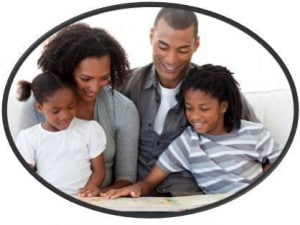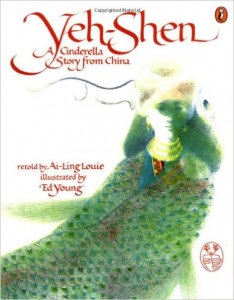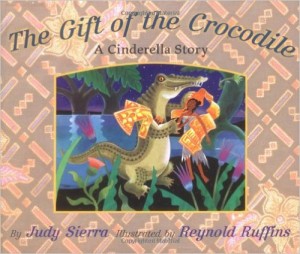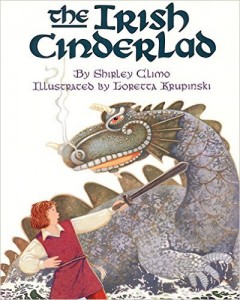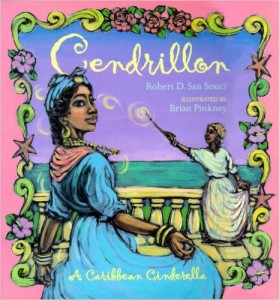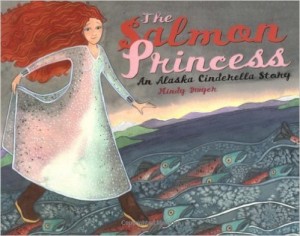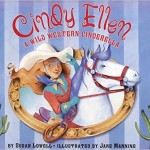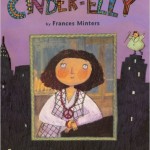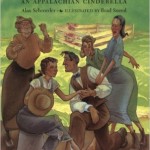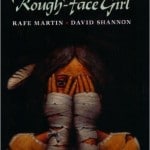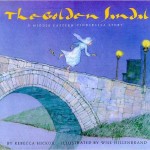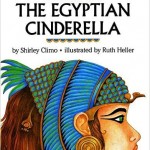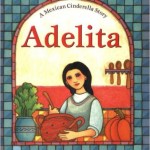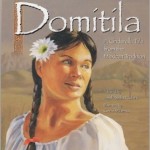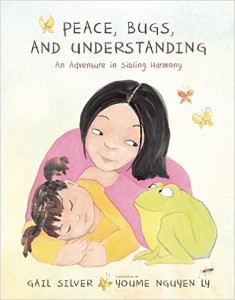Recently diversity has been under siege in our country. More than ever, we must learn about other people, other cultures, other family constellations. Understanding yields acceptance and respect. #DiverseKidLit shines a much needed light on difference. The books reviewed today all focus on what it means to be part of a family, whether in our intimate nuclear families or as part of the family of man. Family is a way of being, of loving, caring, and not just genetics.
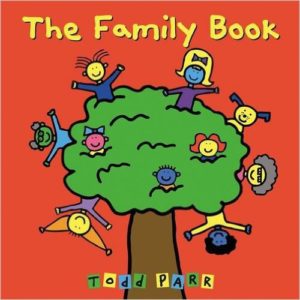 The Family Book written and illustrated by Todd Parr with his signature bold style and brevity, captures the variety and importance of family. His illustrations include diverse “races” (pink, blues, yellow, green, etc.), numbers, and configurations–including single parents as well as same-gender parents. The colorful illustrations catch the eye, hold the reader’s attention and affirm the idea that family is about love and connection. Whether a family looks like our own or not is irrelevant. What is important is that they consider themselves family and love and support one another accordingly.
The Family Book written and illustrated by Todd Parr with his signature bold style and brevity, captures the variety and importance of family. His illustrations include diverse “races” (pink, blues, yellow, green, etc.), numbers, and configurations–including single parents as well as same-gender parents. The colorful illustrations catch the eye, hold the reader’s attention and affirm the idea that family is about love and connection. Whether a family looks like our own or not is irrelevant. What is important is that they consider themselves family and love and support one another accordingly.
 AQ Lens: For adopted children this book can offer a way of discussing differences like race and/or family composition in an abstract way: pink, green and blue people which offers an insulating layer that may make it feel less “personal” and thus “safer” to explore. #AAQ
AQ Lens: For adopted children this book can offer a way of discussing differences like race and/or family composition in an abstract way: pink, green and blue people which offers an insulating layer that may make it feel less “personal” and thus “safer” to explore. #AAQ
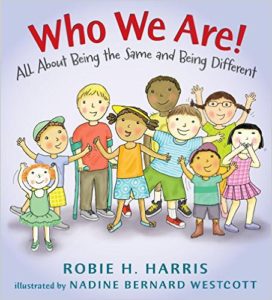 Who We Are by Robie H. Harris and illustrated by Nadine Bernard Westcott, is subtitled: All about Being the Same and Being Different, is straightforward in its efforts to validate diversity in individuals and in their families. It goes into greater detail than Parr’s The Family Book and is appropriate for a slightly older reader. Using the concept of visiting “Funland” as a logical place to encounter an array families, Who We Are focuses on the commonalities that we share and still affirms that each of us is unique.
Who We Are by Robie H. Harris and illustrated by Nadine Bernard Westcott, is subtitled: All about Being the Same and Being Different, is straightforward in its efforts to validate diversity in individuals and in their families. It goes into greater detail than Parr’s The Family Book and is appropriate for a slightly older reader. Using the concept of visiting “Funland” as a logical place to encounter an array families, Who We Are focuses on the commonalities that we share and still affirms that each of us is unique.
The illustrations are broadly inclusive in terms of ethnicity, race, ability, family constellation and body type and activity preferences. The text describes how sometimes differences can make us hesitate or be afraid of people who differ from us in some way. It explains how melanin influences eye, hair and skin color and then highlights the commonalities of the fundamental humanity that we share.
 AQ Lens: For adopted children this book can offer an easy opening to discussing race as well as the many ways in which children can be both different and similar to their adopted families–and/or their birth families if they have an open adoption or knowledge of their birth information. The tone of the book is both affirming and supportive. #AAQ [bctt tweet=”Kids can be both different & similar to both their families–adopted & birth.” username=”GayleHSwift”]
AQ Lens: For adopted children this book can offer an easy opening to discussing race as well as the many ways in which children can be both different and similar to their adopted families–and/or their birth families if they have an open adoption or knowledge of their birth information. The tone of the book is both affirming and supportive. #AAQ [bctt tweet=”Kids can be both different & similar to both their families–adopted & birth.” username=”GayleHSwift”]
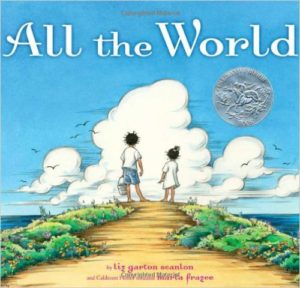 All the World is written by Liz Garton Scanlon and illustrated by Marla Frazee, strives to picture the universals that all people and families share: family love, the pleasure of play–and its variety, parental nurturing, etc. The book repeats the refrain: “All the world is …” then the detailed illustrations capture many ways in which each concept is embodied. The vignettes overflow with examples of variety; we see types of cars, boats, gardens, byways, weather, foods, etc. There’s truly something for everyone. The delicate rhymes conclude: Hope and peace and love and trust/ All the world is all of us.” Children will appreciate that the world surrounds us and is within ourselves as well.
All the World is written by Liz Garton Scanlon and illustrated by Marla Frazee, strives to picture the universals that all people and families share: family love, the pleasure of play–and its variety, parental nurturing, etc. The book repeats the refrain: “All the world is …” then the detailed illustrations capture many ways in which each concept is embodied. The vignettes overflow with examples of variety; we see types of cars, boats, gardens, byways, weather, foods, etc. There’s truly something for everyone. The delicate rhymes conclude: Hope and peace and love and trust/ All the world is all of us.” Children will appreciate that the world surrounds us and is within ourselves as well.
I predict that this atmospheric book will be one which readers will select from their shelves again and again. Each reading will yield a new level of appreciation.
 AQ Lens: adopted children this book can offer a chance to see diversity in a larger swath because the double spread illustrations depict many ways of seeing or experiencing a concept. Instead of seeing difference in an isolated moment or single example, it is seen as part of a complex fabric that holds the varying elements of the spectrum simultaneously.
AQ Lens: adopted children this book can offer a chance to see diversity in a larger swath because the double spread illustrations depict many ways of seeing or experiencing a concept. Instead of seeing difference in an isolated moment or single example, it is seen as part of a complex fabric that holds the varying elements of the spectrum simultaneously.
Here Is the Baby 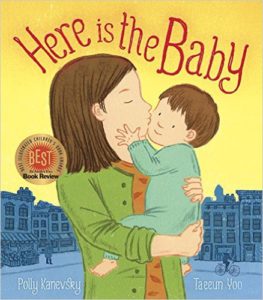 by Polly Kanevsky is a charming book which readers will select from their shelves again and again. It follows a baby throughout his day. Readers travel with him from Mama retrieving him from his crib until she eases him down for his evening’s rest. During baby’s busy day, his parents and sibling, feed, care for and play with him. Clearly he is a well-loved and nurtured child.
by Polly Kanevsky is a charming book which readers will select from their shelves again and again. It follows a baby throughout his day. Readers travel with him from Mama retrieving him from his crib until she eases him down for his evening’s rest. During baby’s busy day, his parents and sibling, feed, care for and play with him. Clearly he is a well-loved and nurtured child.
Daddy is the one who walks sister to school, strolls baby around the neighborhood and brings him to the library for story time and plays with him at the park. This is a welcome depiction of hands-on fathering! Although the family is Caucasian, some limited diversity is represented in the characters who appear in the background.
 AQ Lens: For adopted children this book shows both parents as involved caretakers. though the story depicts a two-parent family, much of the story shows Dad doing the parenting. This may help it appeal to families that have only a father (or fathers). #AAQ Lens
AQ Lens: For adopted children this book shows both parents as involved caretakers. though the story depicts a two-parent family, much of the story shows Dad doing the parenting. This may help it appeal to families that have only a father (or fathers). #AAQ Lens
Our theme for this month’s Diverse Children’s Books linkups is Favorite Children’s Books Featuring an LGBTQ Character(s). (The theme is only a suggestion. Diverse posts on alternate topics are always welcome.)
What Is #DiverseKidLit?
Diverse Children’s Books is a book-sharing meme designed to promote the reading and writing of children’s books that feature diverse characters. This community embraces all kinds of diversity including (and certainly not limited to) diverse, inclusive, multicultural, and global books for children of all backgrounds.
We encourage everyone who shares to support this blogging community by visiting and leaving comments for at least three others. Please also consider following the hosts on at least one of their social media outlets. Spread the word using #diversekidlit and/or adding our button to your site and your diverse posts.
We hope this community will grow into a great resource for parents, teachers, librarians, publishers, and authors! Our next linkup will be Saturday, December 3rd and on the first and third Saturdays of every month.
Upcoming Theme
Our theme for the current linkup is Favorite Children’s Books Featuring an LGBTQ Character(s). Themes are a suggestion only; all diverse book posts are welcome. If you’re interested, you can start planning now for our upcoming themes …
- December 3rd linkup: Favorite Holiday Books. (Please feel free to share any holiday resources, not just winter holidays.) We will only hold 1 linkup in December, which will be open all month long.
- January 7th and 21st linkups: Human Rights. In honor of Dr. Martin Luther King Jr. Day, which is celebrated in the US in January, think about your favorite books to share with children about the importance and the history of human rights and/or civil rights.

Most Clicked Post from Last Time
We Need Family for a Lifetime: November Is National Adoption Month.
In addition to the previous #diversekidlit linkup, Gayle shares several great book recommendations about adoption and adoptive families.
This is an important reminder about making sure that all children and all families find themselves in literature. Thanks, Gayle!
#DiverseKidLit is Hosted by:
 The transition of summer into autumn marks a twist of time that is familiar to all of us, young and old, student and graduate, parent and child. School bells ring across the country, marking the end of summer. Once again, children will leave their homes for the hubbub of school.
The transition of summer into autumn marks a twist of time that is familiar to all of us, young and old, student and graduate, parent and child. School bells ring across the country, marking the end of summer. Once again, children will leave their homes for the hubbub of school.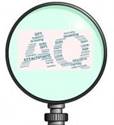 Adoption-attuned Lens: This story might easily trigger a conversation about the connection, longing and questions about birth parents that adoptees have. They may find reassurance in imagining these important people being present in the constants of sun- and moon-shine, raindrops and snowflakes, butterflies and rainbows, storms or changing seasons.
Adoption-attuned Lens: This story might easily trigger a conversation about the connection, longing and questions about birth parents that adoptees have. They may find reassurance in imagining these important people being present in the constants of sun- and moon-shine, raindrops and snowflakes, butterflies and rainbows, storms or changing seasons.

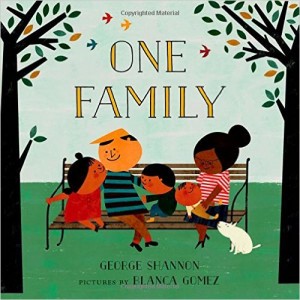





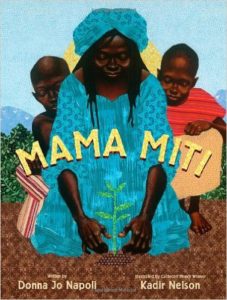

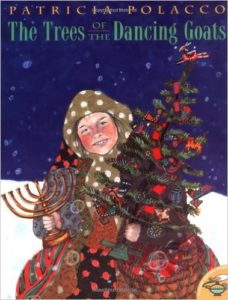





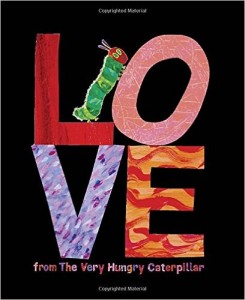
 #AQ Lens
#AQ Lens In Natasha Yim’s picture book,
In Natasha Yim’s picture book, 


